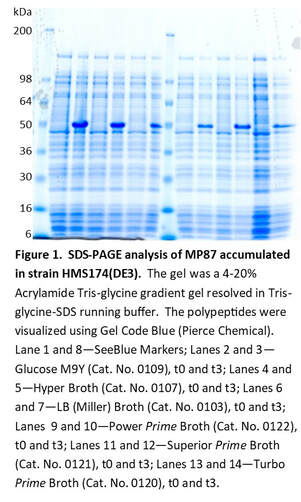Example: MP87 an anti-inflammatory protein
|
Media Screen for Production of MP87
Background: MP8 is a human protein discovered by Meyer Pharmaceuticals with anti-inflammatory properties. The protein induces the shedding of TNF and IL-6 receptors from macrophages and has been shown to mitigate the adverse effects of acute and chronic inflammatory diseases. MP87 is the His-tagged amino terminal portion of the protein which contains the active site (50 kDa). Expression of the MP87 protein in E. coli is controlled by the IPTG-inducible T7 promoter and is carried on the low copy plasmid pACYC184. The protein was used in pre-clinical applications. Methods: To define the production conditions, the plasmid was introduced into a number of host strains. E. coli strain HMS174(DE3) was identified as the strain which accumulated the most MP87 protein post-induction. A media screen was then performed to identify the formulation yielding the highest production levels. Six 250 ml baffle bottomed flasks containing 50 ml of LB (Miller) Broth, Glucose M9Y, Hyper Broth™, Power Prime Broth™, Superior Prime Broth™ and Turbo Prime Broth™ (Athena Enzyme Systems, Cat. No. 0103, 0108, 0107, 0122, 0121, and 0120, respectively) were inoculated with 2 ml of an overnight culture. The cultures were incubated at 37°C for 2 hours with shaking. A 1 ml aliquot was removed for preparation of a whole cell extract and a 5 ml aliquot removed, the cell harvested (centrifugation at 6,000 xg for 10 min) and the cell pellet stored at -20°C. IPTG was added to 1.0 mM. The culture was incubated at 37°C for 3 hours and 1 ml and 5 ml samples processed as above. The whole cell extracts were prepared by harvesting the cells, suspending the cells in deionized water to 10OD and mixing 5 μl of the concentrate with 35 μl water and 10 μl 5x SDS-PAGE loading dye. After 5 min at 100°C, a 10 μl aliquot of the mixture was analyzed by SDS-PAGE. Results: Figure 1 shows the SDS-PAGE analysis. The post-induction samples in all six medium show inducible expression of a 50 kDa polypeptide. While the band from the cells grown in glucose M9Y appeared to have the most protein by visual inspection, densitometry analysis of the gel revealed differences in the total amount of protein loaded onto the gel. The relative amount of MP87 accumulated in each medium is in Table 1. By this criteria, protein accumulation was highest in Superior Prime Broth™. |
Example: Six recombinant strains.
|
SDS-PAGE analysis of total protein from each of six different host-vector strains. Each strain was grown in 25 ml of the respective medium to an OD600 of 0.6, expression induced with 1 mM IPTG and a 1 ml sample removed at 3 h post-induction. The sample was adjusted to give 1OD/ml and a portion analyzed by SDS-PAGE. Panel A – Strain JM109 without a recombinant protein; Panel B to G – Strains harboring plasmids that yield MalE, GST, GFP, I278, TesA, and LypA proteins respectively. Arrows denote the location of the respective recombinant protein. Marker proteins are shown to the left and right of each set of cellular proteins. From left to right in each panel are samples from cells grown in Glucose M9Y, LB (Miller), Hyper Broth™, Power Broth™, Superior Broth™ and Turbo Broth™.
|




